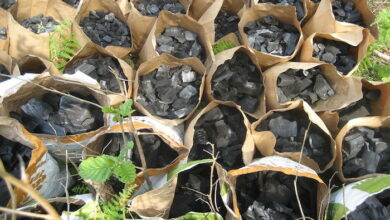
Phytoremediation
Phytoremediation is a biological technique used to restore polluted water and soil environments to their natural state. It involves the use of living plants and their related micro organisms to remove contaminants from the environment or to degrade contaminants to a lesser toxic form (1,2,6). Anthropogenic activities such as mine tailings, fertilizer applications, pesticides, heavy metal disposal, petrochemicals, animal manures and sewage sludges cause soil pollution (2,4,5). Heavy metals are naturally present in the soil but in very small amounts; these metals become contaminants when their amounts rise above the natural levels (2, 8). Industrial activities are key causes of these contaminations. Some heavy metal contaminants are arsenic (As), cadmium (Cd), mercury (Hg), lead (Pb), selenium (Se), uranium (U).
Phytoremediation originates from the Greek word phyton which is translated as ‘plant’ and remedium which translates as to ‘remedy’ (1). This technology is used widely because compared to other remedies; it is less destructive to the soil, and generally affordable (2). Another advantage is that it adds aesthetic beauty to a degraded soil as it involves growing beautiful vegetations. This article will focus on phytoremediation of degraded soil.
Methods used in phytoremediation
1. Phytodegradation: In phytodegradation enzymes released from plant roots are used to degrade contaminants. These enzymes have the special ability to degrade harmful organic contaminants. For example, dehalogenses degrade pesticides and chlorinated solvents, nitroreductases have the ability to degrade nitro aromatic compounds. Poplar trees are commonly used for phytodegradation (1,2).
2. Phytovolatalization: Some plants can take up toxic organic compounds from soil, convert them to non-toxic forms and then release them to the atmosphere through evapotranspiration. A well known example is the use of poplar trees to volatilize trichloroethylene (TCE) (3). Astragalus bisulcatus (the two-grooved milkvetch), and Stanleya pinnata (desert princesplume) also have the ability to accumulate high levels of selenium (1,4).
3. Phytoextraction: This strategy relies on a plants ability to take up and store high concentrations of toxic metals or organic compounds in their aerial parts (figure 1). Plants with this ability are called hyperaccumulators. They are able to detoxify heavy metals in their leaves (5) and other aboveground parts. Some plants with this unique characteristics are Elsholtzia splendens, Thlaspi caerulescens (alpine pennygrass), Pteris vittata (Chinese brake), Astragalus bisulcatus (the two-grooved milkvetch), and Stanleya pinnata (desert princesplume) (1,4).
4. Phytostabilization/phytoimmobilization: Phytoimmobilization as the name implies involves the use of plants to immobilize contaminants (such as heavy metals) in soil. This is based on the ability of some plants to take up and accumulate heavy metals in their root cells or bind contaminants in the humus (1). Contaminated soils are re-vegetated with plants having these characteristics, to stop the movement or spread of contaminants in the soil. Examples of such plants are: Dactylis glomerata (orchard grass) and Festuca rubra (red fescue) (9).
Although the benefits of phytoremediation are obvious it has some limitations. Remediation of contaminated soils is restricted to the depth of the root zones, it is a slow process as it takes years to accomplish, high concentrations of heavy metals may be toxic to livestock if they feed on plants growing on remediative sites (1,7). Phytoremediation is a fascinating process and it proofs that there is much to be learned about the unique abilities of plants. Researchers are continuously looking for ways to improve and effectively utilize this technique.

Bibliography and further reading
1. Favas et al (2014). Phytoremediation of Soils Contaminated with Metals and Metalloids at Mining Areas: Potential of Native Flora, Environmental Risk Assessment of Soil Contamination. Soriano MCH (Ed), InTech- https://www.intechopen.com/books/environmental-risk-assessment-of-soil contamination/phytoremediation-of-soils-contaminated-with-metals-and-metalloids-at-mining-areas-potential-of-nativ
2. Greipsson, S. (2011) Phytoremediation. Nature Education Knowledge 3(10):7 https://www.nature.com/scitable/knowledge/library/phytoremediation-17359669
3. EPA, 1998, A Citizen’s guide to phytoremediation, U.S. Environmental Protection Agency, office of solid waste and emergency response, EPA 542-F-98-011, August.
4. Freeman et al (2006) Spatial imaging, speciation, and quantification of selenium in the hyperaccumulator plants Astragalus bisulcatus and Stanleya pinnata. Plant Physiology 142: 124-134.
5. Rascio N and Navari-Izzo F (2011) Heavy metal hyperaccumulating plants: How and why do they do it? And what makes them so interesting? Plant Science 180:169-181.
6. Bolan et al (2011) Phytostabilization: A green approach to contaminant containment. Advances in Agronomy 112: 145-204.
7. Phytotechnologies- https://www.unep.or.jp/ietc/Publications/Freshwater/FMS7/16.asp
8. Kabata-Pendias (2011) Trace metals in soils and plants, CRC Press, Boca Raton, 4th edition. https://www.petronet.ir/documents/10180/2323242/Trace_Elements_in_Soils_and_Plants
9. Kacprzak (2014) Efficacy of biosolids in assisted phytostabilization of metalliferous acidic sandy soils with five grass species. International Journal of Phytoremediation. 16:593-608.













Gregory Arganda
Thank GOODness for Permaculture. NOW if we humans take notice while there is still time.
The question is what to do with biomass after used for phytoextraction/phytostabilization/phytoimmobilization???